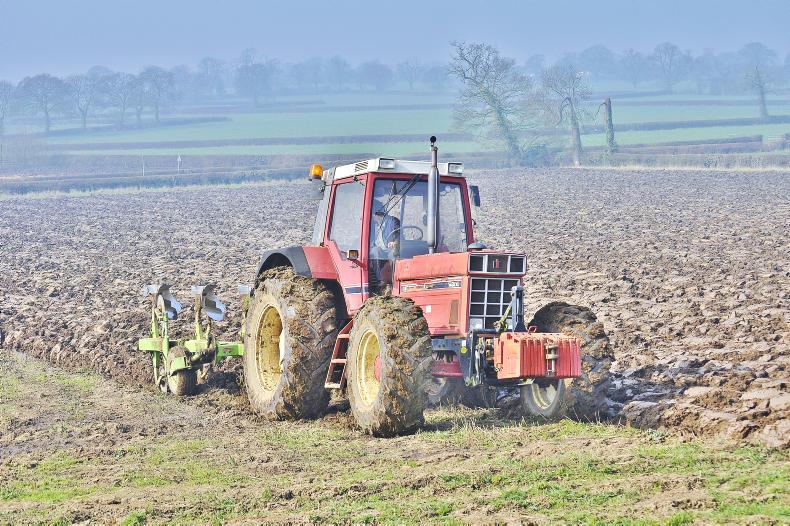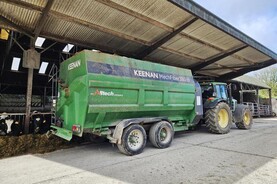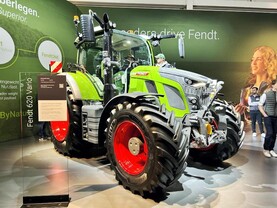The story of the European six-cylinder International Harvester agricultural tractor began in 1971, when International Harvester Corporation (IHC) in Europe introduced the C-Family 946 and 1046 tractors. Assembled at both Neuss in Germany and St Dizier in France, the 946 and 1046 models featured a new ZF transmission, developed specifically for six-cylinder applications.
The 946 model was powered by a Neuss-built IHC D-310 (5.1L) engine, rated at a modest 85hp, which would be increased to 90hp in 1974. The 1046 tractor boasted 100hp, provided by the slightly larger and infinitely superior IHC D-358 (5.9L) engine.
In 1972, the more-powerful 1246 was introduced, featuring a turbocharged DT-358 engine producing 120hp. Like its smaller siblings, it was offered with four-wheel drive, which surprisingly accounted for the majority of European IHC six-cylinder tractor sales at the time.
In 1977, IHC replaced the 946 and 1046 with the new 955 and 1055 models. These featured a fuel tank beneath the tractor’s new rubber-mounted Timmerman Comfort Cab, allowing greater interior space and improved access. The tractor’s livery was also updated to incorporate black and white emblems, as featured on US-built tractors.
Additionally, the new models also featured an improved IHC-sourced transmission/transaxle. Developed from the existing four-cylinder transaxle built at IHC (UK) in Doncaster, the transmission was beefed-up to handle the power of two additional cylinders.
Initially, the 955 retained its forebears’ naturally aspirated D-310 engine. However, this was soon replaced by a detuned (90hp) version of the more capacious D-358. With the exception of its 100hp rating, the 1055 model remained virtually identical to the 955.
In 1981, IHC launched its European range of Field-Force models, introducing the new XL Control Centre. Developed in collaboration with Porsche, the new XL-cab, which was produced at Croix in France, offered a level of refinement matched only by the John Deere SoundGard design.
Initially, the 955 and 1055 were both offered as XL models. However, in 1982, they were replaced by the moderately revised 956XL and 1056XL tractors, which retained the same horsepower ratings. This year also marked the end of six-cylinder tractor production at St Dizier.
In 1979, the C-Family 1246 was replaced by the new D-Family 1255 and 1455 tractors, built exclusively at Neuss. Designed for heavy-draft applications, these were the largest and most powerful tractors produced at the German factory.
While the 1255 retained the 1246 models DT-358 engine (now rated at 125hp), its larger stablemate, the 1455, was equipped with an IHC DT-402 (6.6L) engine, cranking out 145hp at 2,200rpm. Offered as four-wheel drive model only, the 1455 featured a ZF-sourced T-3450 (20F/9R) heavy-duty transmission and offered a rear linkage lift-capacity of 5,600kg.
From 1982 onwards, both the 1255 and 1455 would also be offered as XL models. Interestingly, unlike their C-Family XL stablemates, neither of the D-Family heavyweights would adopt the number six as the last digit of their identity.
In 1985, IHC merged with Case-Tenneco to form Case-IH, incorporating both International Harvester and David Brown/Case tractors into the same product portfolio. At the time, both manufacturers offered six-cylinder models, which following the merger featured a standardised red and black livery.
Case-IH would initially market both product lines, despite a fierce rivalry across Europe between farmers and dealers who were previously loyal to each respective brand. But it was all about to change.
In 1988, the David Brown factory in Yorkshire ceased tractor production. This followed an extensive product rationalisation program by Case-IH, which simultaneously introduced re-styled versions of the popular 956XL and 1056XL models. Production would continue in Neuss, until the launch of the all-new 5100-Maxxum range in 1992.






 This is a subscriber-only article
This is a subscriber-only article














SHARING OPTIONS: